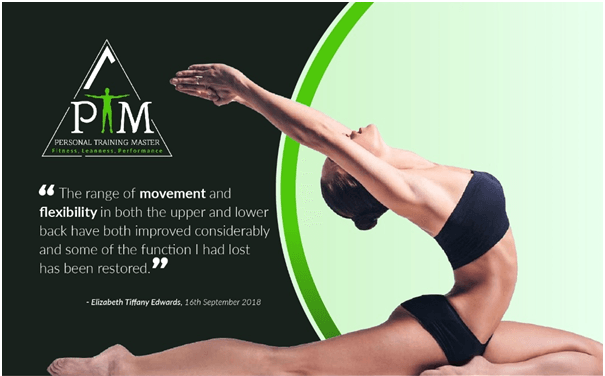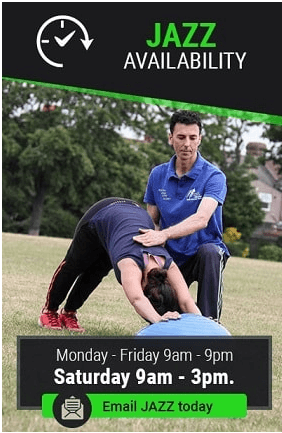The Pilates Method is an exercise system that works to unite the body, mind and spirit (19).
The main focuses of a Pilates training programme include:
- building core strength and stability,
- correcting muscular imbalances and postural alignment,
- decreasing stress on your joints, ligament and muscles through strategically customised training,
- improving your body coordination and neurology
- increasing flexibility, muscle endurance and
- improving your body awareness.
Traditionally, Pilates is taught in one-to-one sessions under the expert eye of an instructor, in order for the training focus to be tailored to the specific needs of each individual student.
There are many benefits to a regular Pilates practice, including improved health and fitness, a lean and toned body, better posture and balance, increased mental focus and coordination, and greater mobility, stability and strength (24).
Pilates conditions the entire body from top to bottom, including the ankles and feet which are often overlooked in other forms of training.
Due to its holistic approach, Pilates provides an excellent foundation for fitness and wellness, complementing any exercise programme and enhancing performance in other sports and physical activities.
Many high-profile athletes, including Daley Blind, Steven Gerrard and Landon Donovan, engage in a Pilates practice in order to decrease risk of injury and improve core activation, balance, mobility and overall performance (4,9,16).
In addition, Pilates creates a slender and toned body and improves posture, making the results of a Pilates training programme aesthetically pleasing.
Countless A-list celebrities, including Gisele Bundchen and Alessandra Ambrosio, commit to a regular Pilates practice because the exercises are designed to give long, lean muscles without adding bulk (6,7).
Training in Pilates also builds natural grace into every moment, which is reflected in the way you walk and carry yourself.
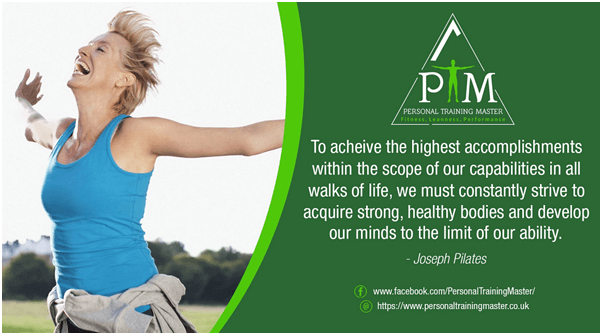
Professional performers such as Beyonce, Miley Cyrus and Madonna swear by the dance-like exercises of Pilates for increasing their endurance, strength, flexibility and overall fitness, without building bulging muscles or compromising their svelte physiques (1,15,26).
Pilates for Better Posture
A healthy spine is critical for general wellness and quality of movement.
Joseph Pilates once said…
“A man is as young as his spinal column. If your spine is stiff at 30, you are old. If it is flexible at 60, you are young.”
Unfortunately, the typical, modern-day lifestyle includes long periods of time spent sedentary, sitting or driving, and our body’s often suffer from improper posture and poor body mechanics as a result (24).
Pilates trains the body to be in harmony, with all movements originating from a strong and stable centre.
By focusing on the development of core strength, preserving the natural curves of the spine, and lengthening and strengthening muscles, in a customised manner Pilates works to correct postural and pelvic malalignment (2,18).
- Are you suffering from back pain or postural problems?
Contact Jazz Alessi now through this link, here.
No Undertrained Muscles and No Over-Trained Muscles
Pilates builds toned, long and strong muscles and gives a leaner appearance, adding grace to your posture and movements.
Additionally, Pilates exercises address imbalances in the structure of the body which can cause pain and faulty movement patterns (2,10).
By consistently working all muscles, including the minor muscles, rather than simply over-developing the larger muscle groups, the Pilates method helps to counteract the consistent overuse of specific muscles.
When all of your muscles are strengthened uniformly, the body is restored to balance and you can move and perform physical work more efficiently and optimally (19).
Improved Flexibility with Pilates Training
Flexibility is important for preventing injuries, improving posture, and enhancing the quality of movement in physical activities(22).
Flexibility requires both adequate length in the muscles and range of motion in the joints.
Using slow and controlled movements, Pilates exercises increase flexibility by promoting joint mobility and lengthening the muscle fibers in a safe range of motion.
In addition, Pilates develops all muscles equally and builds lean and supple muscles rather than adding bulky mass, which also assist in promoting flexibility (14,19).
The Core Muscles are the Main Focus of Pilates Exercises
The center of the body, known as ‘The Powerhouse’, is the foundation for all of your movements in Pilates.
The core muscles are always the first to be recruited before beginning any other movement.
Moving with control from a stable base is important for decreasing risk of injury and maximising the efficiency of your movements (24).
Strengthening the abdominal muscles therefore is a major focus of all Pilates exercises(11).
Improving abdominal strength is critical for childbearing women, as the abdominal muscles are overstretched and under-utilised during pregnancy(8).
Increases in abdominal strength are also proven to help with a wide variety of other ailments, including back pain and poor posture, and assist in healthy reproductive and urinary function (12,14,20).
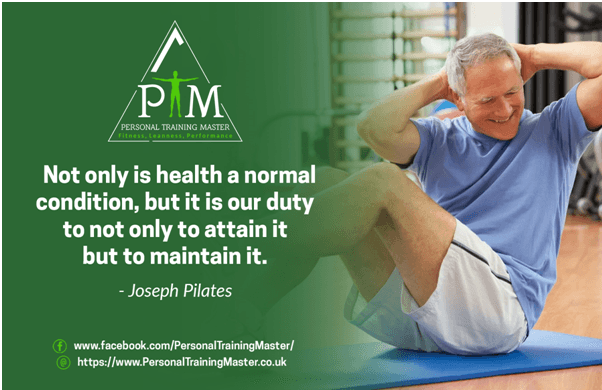
Pilates Training Helps with Stability, Coordination and Balance
The Pilates Method of Exercise was originally referred to as ‘Contrology’ because slow and controlled movements are used in all Pilates exercises and coordination of the body and mind is one of the guiding principles of the practice (19, 24).
Pilates exercises are carefully executed with control and precision, which increases the effectiveness of the movements and reduces the risk of injury, in both exercise and everyday life.
Pilates exercises also work to strengthen the muscles surrounding the joints, thereby creating more stability in the joints and resulting in a more stable, safe and balanced body.
Seniors in particular can benefit from a regular Pilates regime because it improves strength, flexibility, body coordination and balance, which are critical for injury prevention and reducing the risk of falls (3, 14).
Pilates for Disease Risk Management and Reduction of Pain
A regular Pilates exercise programme is one of the most effective ways to increase insulin insensitivity and keep blood sugar levels under control, thus reducing the risk of disease, including diabetes (17).
Additionally, Pilates exercises target the deep muscles that stabilise the body and increase flexibility in the tight, overused muscles, helping to create a more balanced, aligned and efficient body.
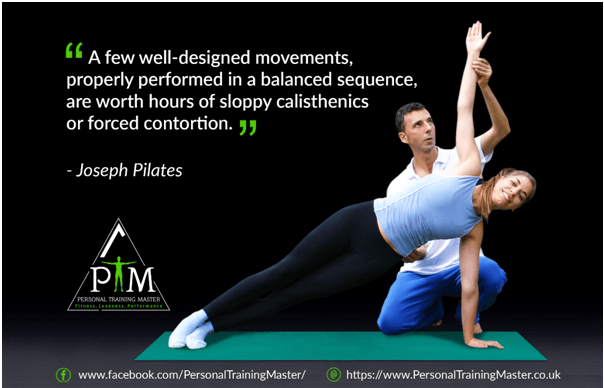
Through balancing the body, Pilates also improves musculoskeletal conditions and dramatically reduces pain levels (2,5,20).
- Would you like to lose weight, and improve your health, spine or posture?
Contact Jazz Alessi now through this link, here
Pilates and the Breath
Proper breathing helps to oxygenate the blood and increase circulation.
Pilates uses a specific breathing technique in order to enhance and facilitate your movements, as well as increase your lung capacity (19).
The quality of your breath is linked to various mental states, including anxiety and depression.
When in distress, it is important to be able to manipulate and control the breath in order to bring yourself back into a state of calm through slow, deep breathing(21).
Develop Greater Body Awareness with a Regular Pilates Practice
One of the main goals of Pilates is to develop body awareness.
Pilates requires sharp mental focus in order to control the actions of the body, and all of the exercises are performed using mindful and meticulous movements (24).
All of your attention is on your body when doing Pilates, and you cannot allow your mind to wander.
It is important to analyse every detail of your form as you move, and perform each exercise as perfectly as possible.
The practice of focusing solely on your body and aiming for conscious control of all of its movements helps to increase body awareness.
Body awareness isan important part ofhealth and wellbeing, because it allows you to listen more deeply to your body’s physical and emotional signals.
A heightened sense of body awareness helps you to be more in touch with yourself, on every level.
Postpartum Women and the Benefits of Pilates
Pilates is the ideal form of exercise for women in the postnatal period.
Following the birth of a baby, gentle but effective exercise is recommended in order to regain strength in areas such as the pelvic and abdominal muscles (8, 14).
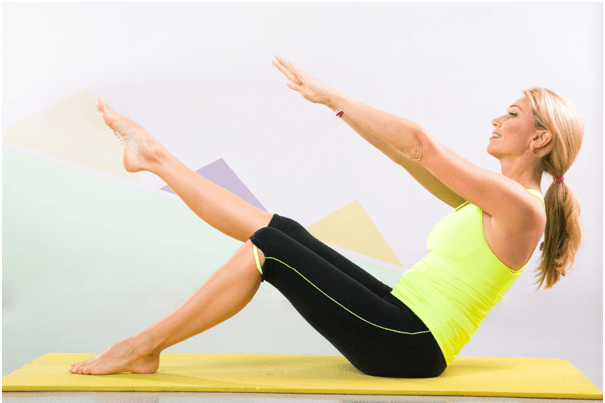
Pilates targets the deep core muscles and builds both strength and stability, which help with injury prevention in the months following the birth and aid postnatal women in conditioning their bodies so that they can return to other more vigorous activities again.
The breathing techniques, strengthening and stretching used in Pilates training will also assist in relieving the stress that often comes with motherhood.
- Would you like to lose weight, and improve your back health and posture?
Contact Jazz Alessi now through this link, here.
Pilates for Knee Injury Rehabilitation
The muscles and ligaments around the knee joint provide support for the knee and should work together in balance to maintain proper functioning of the knee joint.
When there is a lack of strength and stability in these surrounding muscles and ligaments, the knee joint is more susceptible to injury.
A one-to-one Pilates training programme is ideal for rehabilitation following a knee injury because each exercise can be modified, and a certifiedPilates instructor will adjust the resistance and range of motion used, based on the specific needs of the individual, to ensure safety throughout the practice (13).
Pilates exercises are perfect for improving strength, flexibility and alignment in the hips, legs and feet.
A qualified London Pilates instructor will be able to determine exactly where your muscles are imbalanced and create a tailor-made programme designed to stretch the tight muscles and strengthen the weaker muscles in order to bring your body into balance, therefore decreasing your risk of further injury (19).
Pilates Lowers Stress, Anxiety and Depression
Regular exercise has extremely positive effects on people suffering with depression and anxiety.
When you engage in physical activityyour body releases hormones known as endorphins, which boost your mood and make you feel happy and energised.
Exercise also improves your self-esteem and helps to create a more positive self-image (23).
Pilates is a form of mind-body exercise and acts like a meditation, providing a powerful opportunity to practice mindfulness and become present in your
body,and allowing you to relax, release tension and let go of worries and concerns (25).
Pilates also utilises specific breathing patterns, which fully oxygenate the blood, increase blood flow to the brain and calm the nervous system (19).
Many people with anxiety and depression feel a lack of control over their lives.
Pilates requires intense concentration so that you can govern every aspect of your movements.
With regular practice, you will feel a greater sense of mental focus and body awareness, which will be helpful in times of increased stress.
You will feel more capable of regulating your stress levels and empowered with a greater sense of control over your body, mind and life (25).
Pilates is for Everyone
Pilates is an appropriate form of exercise for people of all ages and is designed for every level of health and fitness.
It is a safe form of training because it is low impact and does not put stress on the joints.
A London Pilates training programme starts with beginner, foundational exercises and gradually builds in difficulty overtime.
It is possible to modify exercises whenever necessary, and the entire workout can even be done without standing(11).
Investing in Your Health and Reaching Your Goals
By practicing under the guidance of a trained instructor in a one-to-one session, you can ensure your workout will be specifically tailored to suit your body and its individual needs (24).
Joseph Hubertus Pilates said…
“You will feel better in 10 sessions, look better in 20 sessions, and have a completely new body in 30 sessions.’
Initially, it is recommended to commit to a package of 16-30 private sessions.
Pilates is more effective the more frequently you practice.
By doing Pilates often, you will see results sooner and reach your goals quicker.
Once the exercises are learned under the supervision of a 2nd generation certified Pilates trainer in London, you will be able to practice the exercises at home without any fancy equipment, just wearing comfortable clothes and using only a mat.
- What are your challenges and goals?
- Do you have a question you’d like to be answered?
Contact Jazz Alessi now through this link, here.
References
- ‘Beyonce is gym buddies with Paul McCartney’. MSN, Microsoft News, 20 April 2014, https://www.msn.com/en-au/news/other/beyonce-gym-buddies-with-paul-mccartney/ar-AAgnN3
- Bhadauria, EA, Gurudut, P. Comparative effectiveness of lumbar stabilization, dynamic strengthening and Pilates on chronic low back pain: randomized clinical trial. Journal of Exercise Rehabilitation. 2017;13(4):477-485.www.e-jer.org/journal/view.php?number=2013600413
- Campos de Oliveira L, Goncalves de Oliveira R, Aparecida de Almeida Pires-Oliveira, D. Effects of Pilates on muscle strength, postural balance and quality of life of older adults: a randomized, controlled, clinical trial. Journal of Physical Therapy Science. 2015;27(3):871-876.www.ncbi.nlm.nih.gov/pmc/articles/PMC4395733/
- Clements, A. ‘Steven Gerrard reveals fitness regime which includes Pilates, weight sessions and 90 minutes of training each day’. Daily Mail Australia, Associated Newspapers Limited, 31 October 2014. https://www.dailymail.co.uk/sport/football/article-2815046/Steven-Gerrard-reveals-unique-fitness-regime-includes-Pilates-weight-sessions-90-minutes-training-day.html
- Di Lorenzo, CE. Pilates: What is it? Should it be used in rehabilitation? Sports Health. 2011;3(4):352-361.http://www.ncbi.nlm.nih.gov/pmc/articles/PMC3445206/
- Fraser, D. ‘Beach babe: Victoria’s Secret model Alessandra Ambrosio looks amazing in a bikini on the beach in the Bahamas’. The Sun, News Group Newspapers Limited in England, 13 February 2018.https://www.thesun.co.uk/tvandshowbiz/5568927/victorias-secret-model-alessandra-ambrosio-looks-amazing-in-a-bikini-on-the-beach-in-the-bahamas/
- Groth, LO. ‘How Gisele fine-tunes her famous figure’. Living Healthy, Living Healthy LLC, 24 March 2016. https://www.livinghealthy.com/articles/how-gisele-fine-tunes-her-famous-figure
- Hammer, RL, Perkins, J, Parr, R. Exercise during the childbearing year. Journal of Perinatal Education. 2000; 9(1):1-14.https://www.ncbi.nlm.nih.gov/pmc/articles/PMC1595006/
- Hughes, L. ‘Landon Donovan loves Pilates’. Shape, Meredith Corporation, 23 April 2014. https://www.shape.com/celebrities/interviews/landon-donovan-loves-pilates
- Kloubec, J. Pilates for improvement of muscle endurance, flexibility, balance and posture. Journal of Strength and Conditioning Research. 2010;24(3):661-7.https://journals.lww.com/nsca-jscr/Pages/articleviewer.aspx?year=2010&issue=03000&article=00010&type=Fulltext
- Kloubec, J. Pilates: how does it work and who needs it? Muscles, Ligaments and Tendons Journal. 2011;1(2):61-66.http://www.ncbi.nlm.nih.gov/pmc/articles/PMC3666467/
- Lagro-Janssen, TL, Debruyne, FM, Smits, AJ, Van Weel, C. Controlled trial of pelvic floor exercises in the treatment of urinary stress incontinence in general practice. British Journal of General Practice. 1991;41(352):445-449. https://www.ncbi.nlm.nih.gov/pmc/articles/PMC1371786/
- Levine, B, Kaplanek, B, Scafura, D, Jaffe, WL. Rehabilitation after total hip and knee arthroplasty: a new regimen using Pilates training. Bulletin of the NYU Hospital for Joint Diseases. 2007;65(2):120-5. https://www.ncbi.nlm.nih.gov/pmc/articles/PMC2674181/
- Marques A, Stothers L, Macnab A. The status of pelvic floor muscle training for women. Canadian Urological Association Journal. 2010;4(6):419-424.http://www.ncbi.nlm.nih.gov/pmc/articles/PMC2997838/
- ‘Miley Cyrus: diet plan and workout routine’. Healthy Celeb, 15 September 2013. https://healthyceleb.com/miley-cyrus-diet-plan-workout-routine/6217
- Millar, S. ‘Daley Blind reveals how he is preparing for the new season’. Daily Star, Express Newspapers, 5 July 2015. https://www.dailystar.co.uk/sport/football/451865/Daley-Blind-reveals-preparing-new-season
- Peirce, NS. Diabetes and exercise. British Journal of Sports Medicine. 1999;33(3):161-173. https://www.researchgate.net/publication/12921188_Diabetes_and_Exercise
- Phrompaet, S, Paungmali, A, Pirunsan, U, Sitilertpisan, P. Effects of Pilates training on lumbo-pelvic stability and flexibility. Asian Journal of Sports Medicine. 2011;2(1):16-22.https://www.researchgate.net/publication/221871165_Effects_of_Pilates_Training_on_Lumbo-Pelvic_Stability_and_Flexibility
- Pilates, JH, Miller, WJ. A Pilates’ Primer: The Millennium Edition. Nevada: Presentation Dynamics Inc.; 2000.
- Rydeard R, Leger A, Smith D. Pilates-based therapeutic exercise: effect on subjects with nonspecific chronic low back pain and functional disability: a randomized controlled trial. Journal of Orthopaedic and Sports Physical Therapy. 2006;36(7):472-484.https://www.researchgate.net/publication/6906153_Pilates-Based_Therapeutic_Exercise_Effect_on_Subjects_With_Nonspecific_Chronic_Low_Back_Pain_and_Functional_Disability_A_Randomized_Controlled_Trial
- Salmon, P. Effects of physical exercise on anxiety, depression, and sensitivity to stress: A unifying theory. Clinical Psychology Review. 2001;21(1):33-61.http://www.ncbi.nlm.nih.gov/pmc/articles/PMC3632802/
- Segal, NA, Hein, J, Basford, JR. The effects of Pilates training on flexibility and body composition: An observational study. Archives of Physical Medicine and Rehabilitation. 2004;85(12):1977-1981.http://www.archives-pmr.org/article/S0003-9993(04)00300-4/fulltext
- Sharma, A, Madaan, V, Petty, FD. Exercise for mental health. The Primary Care Companion to the Journal of Clinical Psychiatry. 2006;8(2):106. https://www.researchgate.net/publication/6924343_Exercise_for_Mental_Health
- Ungaro, A. Pilates Body in Motion. New York: Dorling Kindersley Limited; 2002.
- Woodyard C. Exploring the therapeutic effects of yoga and its ability to increase quality of life. International Journal of Yoga. 2011;4(2):49-54. https://www.ncbi.nlm.nih.gov/pmc/articles/PMC3193654/
- Yaneff, J. ‘Queen of pop Madonna’s secret to staying fit and healthy at age 58’. Foods for Better Health.https://www.foodsforbetterhealth.com/queen-of-pop-madonnas-secret-staying-fit-healthy-age-58-18563




